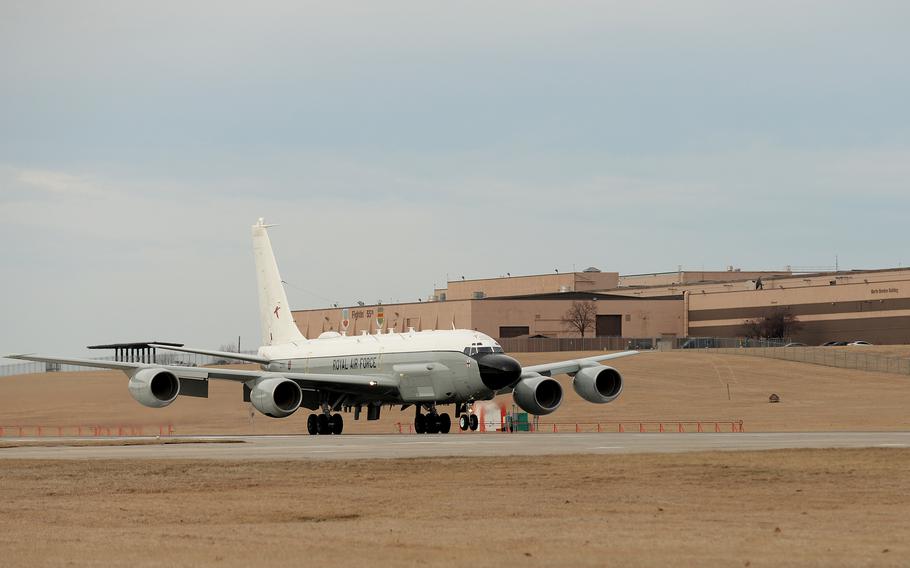A Russian fighter jet nearly shot down a British surveillance plane last year, according to a leaked U.S. military document circulating online, an incident more significant than was previously disclosed and that could have drawn the United States and its NATO allies directly into the Ukraine war.
The near miss occurred on Sept. 29 off the coast of Crimea, the heavily fortified Ukrainian peninsula that Russia seized in 2014 and has used to base its Black Sea naval fleet and launch attacks elsewhere in Ukraine.
The document, one of dozens in a trove of leaked classified Pentagon documents that has triggered a Justice Department investigation, refers to the incident as a “near-shoot down of UK RJ,” a reference to the “Rivet Joint” moniker common for RC-135 reconnaissance planes. The aircraft is used to collect radio transmissions and other electronic messages.
U.K. Defense Minister Ben Wallace disclosed the incident to the British House of Commons in October, saying that two Russian Su-27 fighter jets had intercepted the RC-135 in international airspace over the Black Sea, flying “recklessly,” with one plane coming within 15 feet of the British aircraft.
One of the Russian jets “released a missile” at a distance, Wallace told lawmakers then — but he did not describe the incident as a near-shootdown, attributed the missile launch to a “technical malfunction,” and said he had spoken with senior Russian defense officials about it.
The incident highlights the balancing act that Western military officials have sought to maintain as they attempt to aid the Ukrainian military and collect information about the war without being drawn directly into conflict with Moscow. Russian officials have sought to portray NATO nations as aggressors, while the United States and its allies have said they are supporting Ukraine but are not war at Russia.
Under NATO’s treaty, if a member of the military alliance is a victim of an armed attack, all members of the alliance will consider it an attack and collectively respond.
U.S. defense officials declined to comment about the contents of the leaked document, as they have with other information in the trove that was found on messaging apps including Discord, Telegram and Twitter. An official with the British Embassy in Washington also declined to comment, and the Russian Embassy did not respond to a request for comment.
The document was printed with headers for the Pentagon’s Joint Staff, and details surveillance flights over the Black Sea from the day of the reported near-shootdown up to Feb. 26.
The document is labeled “SECRET/NOFORN,” a classification that indicates it is not to be shared with non-U.S. citizens. It details a number of other Russian reactions to surveillance flights by U.S., British and French aircraft between October and the end of February, including one on Dec. 30 in which another British Rivet Joint, accompanied by two British Typhoon fighter jets, was intercepted by Russian jets that came within 100 feet.
In another instance, a U.S. MQ-9 surveillance drone was intercepted on Feb. 22, with Russian aircraft coming within 100 feet. About two weeks later, on March 14, two Russian Su-27 jets intercepted an American MQ-9, dumping fuel on the unmanned aerial vehicle and eventually colliding with it. The collision prompted U.S. personnel remotely piloting the vehicle to down it in the Black Sea, about 56 miles off the coast of Crimea, U.S. officials have said.
A map on the document shows a boundary drawn over sections of the Black Sea to mark where surveillance planes may fly. It appears to begin about 12 miles off the coast of Crimea, adhering to international law. The map also includes a second line about 50 miles from the shore labeled “SECDEF Directed Standoff,” indicating that Defense Secretary Lloyd Austin may have ordered U.S. pilots to keep aircraft farther from the peninsula.
Austin said in March that the United States will continue to fly “wherever international law allows,” rejecting Moscow’s claim to a self-declared exclusion zone over extended parts of the Black Sea.
French and British aircraft made crewed surveillance flights over the Black Sea between Sept. 29 and Feb. 26, according to the document, while the Americans relied on drones that include the RQ-4 Global Hawk, the RQ-170 Sentinel and the MQ-9 Reaper. A handful of these flights occurred each month, the document said. U.S. military officials have said they typically file public flight plans for such flights.
Gen. Mark A. Milley, chairman of the Joint Chiefs of Staff, in March called Russian behavior in the downing of the MQ-9 in March part of a pattern of aggressive acts toward the United States, Britain and other nations.
“We have to figure out exactly what the way ahead is,” he said at the time, speaking at a Pentagon news conference. He characterized the behavior of Russian pilots as “very unprofessional and unsafe.”
A Pentagon spokesman, Brig. Gen. Patrick Ryder, said last month that it’s important to keep the Black Sea and the skies over it open to all nations.
“The Black Sea,” he said, “is a critical international seaway supporting many of our NATO allies, including Romania, Bulgaria and Turkey, and does not belong to any one country.”

A Royal Air Force RC-135 lands at Offutt Air Force Base, Neb., in 2017. (Delanie Stafford/U.S. Air Force)